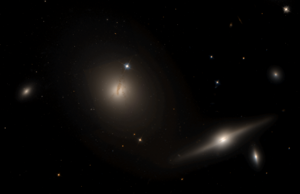NGC 705 facts for kids
NGC 705 is a fascinating lenticular galaxy located in the Andromeda constellation. It's quite far away from our own Milky Way galaxy, about 208 million light-years distant. Imagine how long it takes for light from NGC 705 to reach us – 208 million years! This means when we look at NGC 705, we are actually seeing it as it was 208 million years ago.
Contents
What is a Lenticular Galaxy?
NGC 705 is known as a lenticular galaxy. This name comes from the word "lentil," which is a type of bean that is flat and round. Lenticular galaxies are a bit like a mix between two other common galaxy types: spiral galaxies and elliptical galaxies.
Spiral Galaxies
Spiral galaxies, like our Milky Way, have a flat, spinning disk with spiral arms. These arms are full of gas, dust, and young, bright stars.
Elliptical Galaxies
Elliptical galaxies are more like giant, round or oval-shaped balls of stars. They don't have clear spiral arms and usually contain older stars.
The Lenticular Difference
Lenticular galaxies have a flat disk shape, similar to spiral galaxies, but they don't have those distinct spiral arms. They also have a large bulge in the center, much like spiral galaxies. However, they usually have very little gas and dust, which means they don't form many new stars. This makes them look a bit older and less active than spiral galaxies. Scientists believe that lenticular galaxies might have once been spiral galaxies that lost their gas and dust, perhaps through collisions with other galaxies.
Where is NGC 705 Located?
NGC 705 is found in the Andromeda constellation. This constellation is named after Princess Andromeda from ancient Greek myths. It's one of the most famous constellations, especially because it's home to the Andromeda Galaxy (M31), which is the closest large galaxy to our Milky Way.
Finding Andromeda
The Andromeda constellation can be seen in the northern sky. It's best viewed during the autumn months in the Northern Hemisphere. You can often find it by looking for the "Great Square of Pegasus" and then extending a line from one of its corners.
How Far is 208 Million Light-Years?
When astronomers say NGC 705 is 208 million light-years away, it means the light we see from it today started its journey 208 million years ago. A light-year is the distance light travels in one year. Light travels incredibly fast, about 300,000 kilometers (186,000 miles) per second!
A Glimpse into the Past
Because light takes so long to travel across space, looking at distant galaxies like NGC 705 is like looking back in time. The light from NGC 705 that reaches us now left the galaxy when dinosaurs were still roaming the Earth! This allows scientists to study how galaxies looked and behaved in the distant past.
Discovery and Research
NGC 705 was first discovered in the year 1786. This was a time when astronomers were using some of the first powerful telescopes to map the night sky. Discoveries like NGC 705 helped us understand that our universe is much larger and contains many more galaxies than people had ever imagined.
Part of a Galaxy Cluster
NGC 705 is not alone in space. It is part of a group of galaxies known as Abell 262. A galaxy cluster is a huge collection of galaxies that are held together by gravity. Studying galaxies within clusters helps scientists understand how galaxies interact with each other and how they evolve over billions of years.
Why Do We Study Galaxies Like NGC 705?
Astronomers study galaxies like NGC 705 for many reasons. By observing their shapes, sizes, and how they move, scientists can learn more about:
- Galaxy Evolution: How galaxies form, change, and grow over cosmic time.
- Dark Matter: The invisible substance that makes up a large part of the universe. The way galaxies spin and interact helps us understand where dark matter might be.
- The Universe's Expansion: By measuring how far away galaxies are and how fast they are moving away from us, scientists can learn about the expansion of the universe itself.
Every galaxy, even one as distant as NGC 705, helps us piece together the amazing story of our universe.


